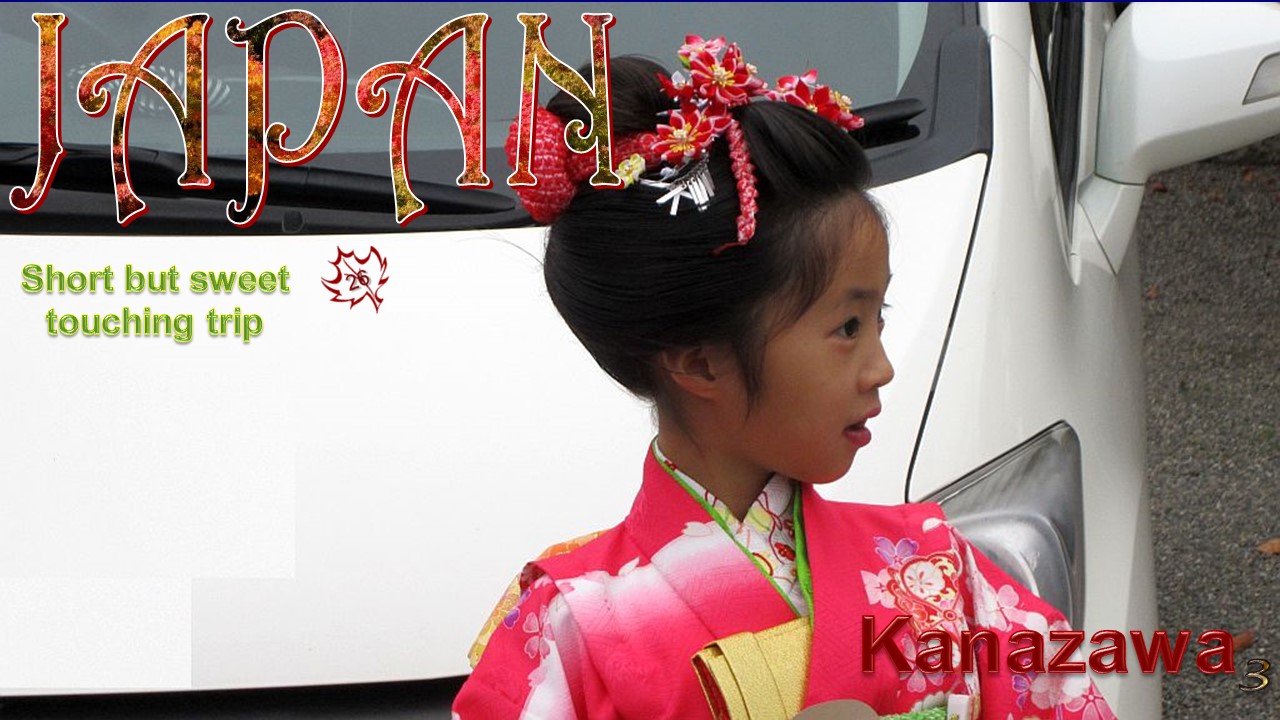Japan 26 Kanazawa 3 PowerPoint PPT Presentation
Title: Japan 26 Kanazawa 3
1
JAPAN
Short but sweet touching trip
Kanazawa
3
2
Ishikawa Prefectures capital, Kanazawa, was one
of the few major Japanese cities to escape
bombing by the US Air Force during World War II.
Consequently, parts of the old castle town have
survived intact, making the city a viable
alternative to the more famous Kyoto for
exploring traditional Japan
3
A chaya (lit. teahouse) is an exclusive type of
restaurant where guests are entertained
by geisha who perform song and dance. During
the Edo Period, chaya were found in designated
entertainment districts, usually just outside the
city limits. Of the three districts of Kanazawa,
the Higashi Chaya District (Higashi Chayagai) is
the largest and by far the most interesting
4
(No Transcript)
5
(No Transcript)
6
(No Transcript)
7
(No Transcript)
8
(No Transcript)
9
(No Transcript)
10
(No Transcript)
11
(No Transcript)
12
(No Transcript)
13
(No Transcript)
14
(No Transcript)
15
(No Transcript)
16
(No Transcript)
17
(No Transcript)
18
(No Transcript)
19
(No Transcript)
20
Yukitsuri, a common sight in Kanazawa during the
winter months, is a Japanese technique for
preserving trees and shrubs from heavy snow.
Trees are given extra support by bamboo poles
with ropes attached to limbs
21
The construction of two-story houses except chaya
houses was prohibited in the Edo period. A chaya
house is characterized with a beautiful lattice
called "kimusuko" on the outer side of the first
floor and Japanese-style guestrooms located on
the second floor
22
Nandina domestica (heavenly bamboo or sacred
bamboo), is a species of flowering plant. The
fruit is a bright red berry 510 mm diameter,
ripening in late autumn and often persisting
through the winter
23
HAIKUWhite flowers will bear red fruits Nanten
is the plant to purify I stand under it for
purification
24
Because its name suggests the expression nan o
tenzuru to overturn misfortune or adversity),
nanten has traditionally been regarded as an
auspicious plant. Warriors of old put its leave
in their armor to ensure victory.Nanten was also
used as an alcove ornament for coming-of-age
ceremonies (Genpuku), and pregnant women were
known to place sprays of nanten under their
coverlets to ensure a safe delivery http//www.you
rsourceinjapan.com/motifs.htm
Ogata Gekko - Comparison of Beauties and Flowers
Nandin, 1898
25
(No Transcript)
26
(No Transcript)
27
(No Transcript)
28
(No Transcript)
29
Black-glazed tiles (Kawara) The use of tiles on
the frontage and boards under the eaves is to
prevent snow damage
30
Red berry
31
(No Transcript)
32
One thing which often surprises tourists when
they walk through the Higashi Chaya District in
Kanazawa is the ears of corn hanging from the
eaves of houses. The origin of this custom lies
in the annual "46,000 Days Festival" held during
the summer at the Temple of Kannon (Kannon-in) in
Higashiyama, Kanazawa. Worshipers who visit the
temple on this day are said to receive 46,000
days' portion of heavenly rewards from the
Goddess Kannon. Visitors buy ears of corn that
have been blessed with a prayer, and hang them on
the eaves of their houses to cast out evil and
attract good fortune. Corn with many kernels are
said to symbolize prosperity and hairy husks are
said to bring in profit or drive away demons
33
With shops also dealing in kimono rentals,
visitors can also have fun walking around the
area dressed in kimono
34
Many buildings along the central street now house
cafes and shops. One of the shops, Hakuza, sells
gold leaf products, a specialty of Kanazawa, and
displays a tea ceremony room which is completely
covered in gold leaf. The name "Kanazawa", which
literally means "marsh of gold", is said to
derive from the legend of the peasant Imohori
Togoro (lit. "Togoro Potato-digger"), who was
digging for potatoes when flakes of gold washed
up.
35
Arts Crafts
Tea
36
Gold leaf cake for tea
37
Gold leafing Maneki-neko (welcoming cat or lucky
cat)
38
Omikuji, random fortunes written on strips of
paper
Torii of Utasu Shrine (near Higashi Geisya
district), Shrine to Protect Against Evil
39
Utasu Shrine In 1599, this shrine secretly
deified the spirit of the first Maeda lord
40
Located north east of Kanazawa castle, an ominous
direction according to Onmyodo mysticism, they
enshrined his spirit here to protect the family
from evil
41
(No Transcript)
42
Utasu Shrine One of the two Shisa, resembling a
cross between a lion and a dog, wards, believed
to protect from some evils. When in pairs, the
left shisa traditionally has a closed mouth, the
right one an open mouth. The open mouth wards off
evil spirits, and the closed mouth keeps good
spirits in. They are traditionally used to ward
off evil spirits
43
Ema (small wooden plaques on which Shinto worshipp
ers write their prayers or wishes) and Omikuji,
random fortunes written on strips of paper
44
(No Transcript)
45
Shichi-Go-San (lit. "Seven-Five-Three") is a
traditional rite of passage and festival day in
Japan for three- and seven-year-old girls and
three- and five-year-old boys
46
(No Transcript)
47
(No Transcript)
48
(No Transcript)
49
(No Transcript)
50
(No Transcript)
51
(No Transcript)
52
(No Transcript)
53
(No Transcript)
54
(No Transcript)
55
(No Transcript)
56
Text Internet Pictures Sanda Foisoreanu
Nicoleta Leu Internet All
copyrights belong to their respective owners
Presentation Sanda Foisoreanu
2016
Sound Traditional Music of the Japanese
Geisha by Hideo Osaka Ensemble
57
Kanazawa

